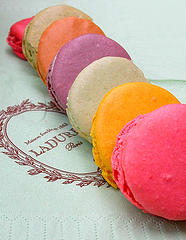Let Them Eat Cake
 Inspired by the almost good enough to eat pictures of Sophia Coppola's indulgent take on Marie Antoinette's life which looks like a box of jewel coloured Parisienne macarons on film – I am going to blog about cakes...
Inspired by the almost good enough to eat pictures of Sophia Coppola's indulgent take on Marie Antoinette's life which looks like a box of jewel coloured Parisienne macarons on film – I am going to blog about cakes...Thanks to his books on pastry and chocolate, Pierre Hermé is no longer a hidden secret among the privileged or the well-travelled. I have made his Suzy's Cake many times to the swoons of friends and family. Those who are not keen to go into the kitchen can sample his macarons and now world-famous Isaphan in Paris and Tokyo. The master credits his affinity to the subtle tastes and delicate textures of the Orient. It is therefore not surprising that there is a growing number of Japanese pâtissiers bursting onto the international scene.
Why are most Oriental pastry chefs Japanese? It may have something to do with their tea culture. Not only is tea drinking an important part of one's daily life there, chadō (茶道) or the tea ritual is an art the Japanese treat with deep respect.
The sansei (teacher) and her students are all dressed in formal kimonos (each gown costs upward of US$2,000) while they sit in meditative silence to make and then drink tea. Each movement is measured and practised. The tea made with Matcha during a tea ceremony is usually extremely concentrated. Sweets or pastries are an essential part of this experience. Traditional sweets are called 和菓子/ wa-gashi (Japanese sweetmeats), they are the ones used on these occasions and their intense sweetness is a deliberation to balance the pronounced tannin in the tea.
Since tea culture is so entrenched, the modern concept of a leisurely afternoon tea has taken roots among the Japanese ladies. In these cases, lighter 洋菓子/ yo-gashi (Western sweetmeats) are more appropriate. When there is a market, there is a training ground for young talents.
The most famous among them is the Paris-based Sadaharu Aoki. Indeed, the Kumquat and Earl Grey Tea Mousse cake which I posted earlier was inspired by this master's creation named Valencia. Keiko of Nordljus who is an artisan in a domestic kitchen features his creations regularly.
Another master is the Tokyo-based Hidemi Sugino. His shop, Idemi, in Kyobashi routinely has a long queue outside. Production is limited due to the master's insistence that although he couldn't make every cake from start to finish, he wants to make sure each one is touched by him personally. Hence, they are sold out around noon everyday. His book, Le Goût Authentique Retrouvé, in Japanese has yet to be translated into English. Meanwhile, we can turn to Keiko's photos to catch a glimpse of this pâtissier's imagination.
Another country which has wowed the culinary world in recent years, Spain, is also producing a number of master pastry chefs. Francisco Torreblanca and Oriol Balaguer are the equivalents of superstar Ferran Adrià in sweet arts. Their creations also lean towards the lighter, subtler tastes with zen-like, oriental inspired presentations which seems to be very much in vogue these days. Their considerable tombs in English are available at Amazon.com for an equally considerable sum.
Would this trend eventually land on these shores and transform the look of our frumpy Pasta Frola and more? I am putting my bets on those on-the-pulse young pastry chefs at Filosofía de Sabor but while we hope and wait, we can try to make a proper Linzer Torte which is what the heavy sickly sweet slab is purportedly trying to imitate.
Linzer Torte:
280g unsalted butter
125g caster sugar
juice and rind of 1/4 orange
280g plain flour
1 egg
95g ground hazelnut (or almond meal)
pinch of bi-carb soda
1g clove
1/2 tsp of ground cinnamon
pinch of salt
good quality raspberry jam
Mix butter and 1/2 of dry ingredients in a mixer. Then allow the butter to be "beaten" to pieces, then add in the rest of the dry ingredients. Mix until the mixture becomes crumbly. Add zest, orange juice and 1 egg.
If the mixture looks like it doesn't need much liquid, then don't add so much orange juice. Mix till ingredients are well incorporated. Then rest in the fridge. But if it's not too soft and can be rolled out, go ahead and roll till 12mm.
Line the pastry on a greased tart tin. Spread jam, but not too much. Just a thin layer. Then with the remaining dough, roll out till about 5mm thick then cut strips and arrange it in lattice pattern. Egg wash before baking for shine.
Bake at 190 C for about 35-40 minutes or till golden. If jam bubbles, it's overbaked so watch the last 5 minutes.


<< Home